Hey all!
In the spirit of the festival of Diwali, I decided to write on a topic that may be relevant to the festival!
Most people know that Sir Isaac Newton hypothesized three laws that shaped classical mechanics. The third law is probably the most commonly known of the three: “Every action has an equal and opposite reaction.”. When questioned about its modern application, people often respond that’s what makes rockets go up, into outer space. Well, today I shall be writing about the various propulsion systems used in modern rockets, which provide this extraordinary amount of “Pushing Force” required to lift off from the ground.

Rocket Propulsion systems generate a change in momentum of a body by ejection of a fluid (called the propellant) or any other form of matter at high velocities in the opposite direction. These are classified mainly into solid propulsion systems and liquid propulsion systems.
Solid Rocket Boosters(SRB): These are the big towering structures attached to the sides of a space vehicle. The solid rocket boosters contain the rocket fuel in the form of a solid block (called the grain) that is insulated and stored within the body. The solid rocket boosters, once ignited, cannot be stalled. The SRB has a quite efficient performance within the atmosphere and is generally used as the first stage for most space launch systems. Some examples of Solid Rocket boosters are seen on the Ariane 5 and the Atlas V aircraft. Modern rockets such as the Falcon 9 first stage are also being tested to achieve recovery and reuse after a successful mission.


Liquid rocket engine: The Liquid rocket engine can be either a bi-propellant or a mono-propellant engine. A bi-propellant system uses a combination of two liquids: the liquid fuel and the oxidizer, which are mixed and ignited in high pressure and temperature combustion chambers. A mono propellant system uses a single liquid fuel, which may or may not be ignited to generate the thrust force. The major advantages of using Liquid fuel engines is that they can be shut-off and turned on again at will. Another advantage is the possibility to control and throttle the amount of thrust that the engine produces. Liquid engines are also more efficient than solid engines beyond the Earth’s atmosphere. However, they are bulky and require a greater number of parts than the solid rockets. The fuel used for a lot of spacecrafts are generally some combination of methyl-hydrazine or kerosene with liquid oxygen as the oxidizer.


Nuclear Engine: A nuclear engine uses the high amount of heat generated by a radioactive isotope to heat a liquid fuel system which generates high pressure and velocity gases that are expelled from the aft nozzle. To date, no nuclear engine has successfully flown from the surface of the Earth. The engine however, generates a very high exit gas velocity, thus allowing a large amount of thrust force, up to twice the amount from a conventional LOX engine.

Ion-Propulsion: Ion propulsion involves using the high velocity stream of charged electrons or ions released by electrical excitation of a gas such as Xenon. Ion propulsion produces a very low amount of thrust but is superior in efficiency to any of the other propulsion methods. The only catch to this is that Ion propulsion cannot be operated with a high payload and can only be employed in a vacuum. Spacecraft have used Ion-propulsion systems successfully for maneuvering satellites after they have escaped the Earth’s atmosphere.

Challenges in Design:
There are a lot of challenges in designing a rocket propulsion system for a specific spacecraft application.
- The hot temperatures and pressures of the exhaust gas limit the duration of possible burns and hence, our reach into the cosmos.
- The amount of fuel that a spacecraft carries will impact the thrust it achieves and limits the amount of payload it can take with it.
- To efficiently utilize rocket propulsion, a process known as staging is used, wherein, the spacecraft sheds the excess weight as it rises higher from the Earth’s surface.
- Another parameter that constrains propulsion is the rigidity of the structures used. There is a need for a trade-off between the strength and the weight of the structure.
- The fuels used in most rocket systems such as Liquid Oxygen also needs to be stored at very low temperatures to keep it in its liquid state up until the time to launch.
Rocket science is quite complex indeed!
Well, I hope this post was informative and offered an insight into propulsion systems.
Until Next time! 🙂
References and further reading:
- Sutton Biblarz-Rocket Propulsion Elements
- https://www.grc.nasa.gov/www/k-12/airplane/rocket.html